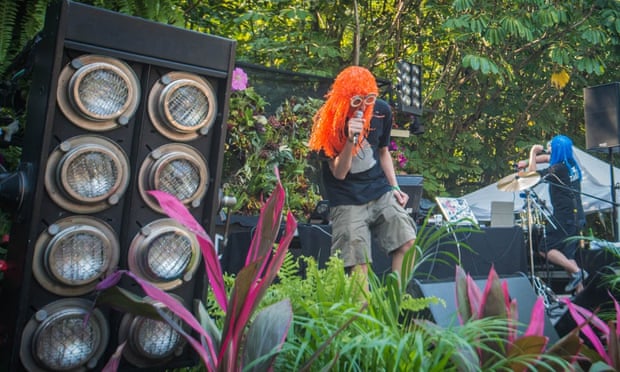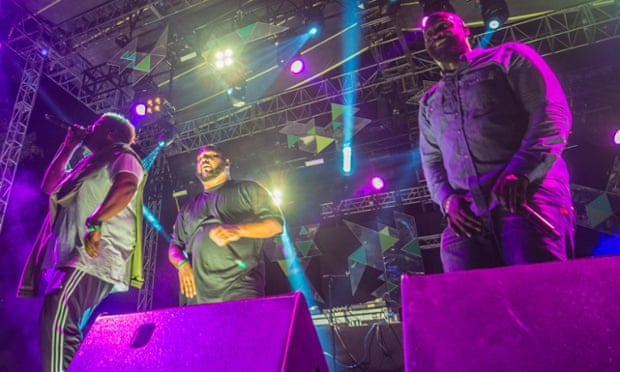Bahidorá y los festivales en México "This is paradise, but with better music" The Guardian
Jiménez echoes these sentiments about escapism. “Music festivals are important not just because this is what we have as an answer to the global music industry, but because in a country such as ours, it is really necessary to have an active cultural life to counteract violence,” she says. “Violence and crisis are our social reality and it’s devastating.
Jiménez continúa…
“I’m not saying that people here are conscious of it while attending to music festivals,” Jiménez continues, “but maybe beneath all this cultural activity lies an alternative to our difficult situation. Maybe music still can be a way to achieve peace.”
Esta mañana mi amigo Martin Duncan (Perth, Escocia), un techno turista radicado en NYC que viaja por todo el mundo siguiendo las mejores fiestas y festivales me compartió este artículo por facebook.
“Voy pronto a México, ¿a qué festival debería ir?”
Con este tipo de artículos muy pronto México estará dentro del circuito de los festivales internacionales y esta es una gran noticia, pues entre más turismo, más fuente de trabajo para todos los involucrados y los que se quieran involucrar. Siempre lo he predicado y practicado: la música nos va a salvar. Naomi Palovits

A DJ in a tribal wolf mask – who turns out to be the elusive producer Slow Magic – is playing the festival’s closing set, pounding two congas emphatically in time to his laptop’s euphoric synth sounds. The stage is crowned by flowers and juts out into a turquoise river, in which Mexico’s beautiful people are bobbing in bright bikinis and feather headdresses, or Aztec-print board shorts and thick-rimmed glasses. Others are sprawled out on dinghies, beer in hand. Palm trees sway in compliance, shading the crowd from the heady heat.
This is paradise, but with better music. And more hipsters.
Bahidorá is one of the global festival circuit’s best-kept secrets. It grew out of independent shows put on by Distrito Global and Volumen/Ache in Mexico City three years ago and offers one hedonistic 24-hour party for 6,000 people in an Instagram-ready resort a few hours south of the capital. A casual glance around and it could be anywhere in Europe or the US: gentle indie acts like CocoRosie, Polica and Matthew Dear have appeared on the lineup before, carefully curated to blend in with the festival’s fey aesthetic. This year, meanwhile, indie and electronic tastemakers like Kindness, Modeselektor and Mac DeMarco are billed alongside hip-hop dons De La Soul and Latin American fusion bands such as La Yegros.

Its organisers describe it as less a festival and more of a carnival: there are impromptu processions with traditional Chinelos dancers, as well as magicians and art installations. It’s heavy on the extracurricular activities, too, and when you’re not sunbathing, swimming or swigging, you can kayak, have a massage and learn circus skills.
Come 6am, the party zombies push on until sunrise, or take a nap in their tents, but this is far from the Spring Breakers scene I was expecting. Around 75% of attendees come from Mexico City, 15% are from the rest of Mexico and just 10% are international. The resulting atmosphere is more that of a Berlin after-hours club: cosmopolitan, convivial and considerate. And very, very hot.
Boutique festivals like these are big business on the global festival circuit, but they have only just started to crop up in Mexico. Bahidorá is the first of a new wave catering to a growing audience that wants high-end production and heightened live music experiences in unique locations. Ceremonia, in May, takes place on a racetrack outside Toluca, surrounded by a forest. Its diverse lineup includes rappers Snoop Dogg and Pusha T, Brit garage-punkers the Horrors, Australian soulster Chet Faker and techno and house DJs like Daniel Avery and Art Department.

The punkier Nrmal in Mexico City, meanwhile, has been likened to the Mexican ATP and featured Swans, Future Islands, Phantogram, Omar Souleyman, Huerco S and many more leftfield names. Another indicator of Mexico’s budding cool, the avant-garde UK indie label Mute is headed to Mexico City on 21 March to curate a day of the free Punto de Encuentro festival (not to be confused with Mutek, an annual electronic festival that’s been going in the capital since 2003).
New independent festivals have headed to the seaside, too. The granddaddy is Mexico’s answer to Miami’s Winter Music Conference, the BPM festival, which has been at Playa Del Carmen since 2008. But a new indie festival, Trópico, in December, has been taking over Acapulco beach for the past two years with artists like Blonde Redhead, Kelela and DJ Harvey in tow.
Likewise, in bohemian Tulum on the Mexican Caribbean coast, UK label Young Turks kicked things off with a New Year’s Eve party in 2013 featuring the xx, Grimes, Four Tet and FKA Twigs among the acts. But now other promoters have followed suit: Aurora, on New Year’s Eve in 2014, for example, was headlined by electronic DJs Odesza, Gold Panda and Aeroplane.

Events like these are keen to be seen as part of what Bahidorá co-founder Iñigo Villamil calls a “global culture” of music fans in touch with international trends, which is small but spreading among the 20 million residents of Mexico City. “Everyone is hungry for a party,” says Uriel Waizel, a well-known music critic and radio broadcaster, “and I guess Mexico wants to belong to an elite of cosmopolitan cities.”
Claudia Jiménez, editor at Noisey Mexico, agrees that Mexican music festival culture is growing exponentially. “That’s a hipster thing that is going massive,” she says. “Now non-hipster people, music lovers and millennials are attracted to the idea of music festivals as social events.”
The upshot of this spurt in popularity is that Bahidorá and their contemporaries hope to be recognised on an international level, so that they can book more American and British bands and attract more overseas visitors. Many heritage acts, for example, haven’t been to the country in years – or often, and especially in the case of newer bands like Kindness, ever before. “Alternative music live events were an unreachable thing in Mexico until maybe 13 years ago, so there are a lot of 90s bands that are still coming for the first time to Mexico,” says Jiménez. It’s why, at Bahidorá, an act like De La Soul is such a huge draw.

However, it also justifies the criticism that in hosting the international acts and trend-conscious festivalgoers that appeal to brands – Doritos and Timbaland are among the sponsors visible at Bahidorá, for example – it comes off like Urban Outfitters doing a festival in a tropical Mexican oasis. The festival is inclusive insofar as Mexico City is a diverse place, but there is a clear divide between the mestizos and ex-pats who turn up to party, and the indigenous Mexicans who turn up to clean up after them.
Others are frustrated at the lack of local music represented. While Bahidorá features a lot of artists from across South America, Europe and the US, there is just one Mexican band on the bill (Ratbot) and two Mexican DJ collectives.
“This is the kind of lineup you would expect to find at SXSW,” says Nahum Mantra, an artist who is giving a talk at the festival. “But as much as Bahidorá needs to aim internationally, they also have to look at home. It’s OK to let creativity and local taste emerge. The question is, how to be part of that global culture and how to also root it here and have more Mexican bands? Or, to put it another way: how do you make the festival different, apart from having amazing weather?”

The fact that a festival like Bahidorá is happening at all, however, is a feat in itself. Even the largest Mexican festivals like Corona Capital or Vive Latino are relatively young compared to Lollapalooza and Glastonbury. “We’re still a long way from having our own Primavera Sound or a Bennicàssim,” says Jiménez, “but we have two huge festivals organized by one promotions company and the rest by young entrepreneurs trying to make things happen.”
Their DIY approach to putting on festivals has largely been a case of trial and error. “Ten years ago, music festivals in Mexico were super-indie and amateur,” says Jiménez. “They were branded but not in an aggressive way, and nobody seemed to have any idea of what they were doing. But now there is a generation of people who have grown up producing festivals and music events and have learnt from each bad experience.”
Small-scale festivals were once particularly scarce thanks to the poor organisation of ones who tried and failed. Villamil mentions one in 2008, Colmena, which messed up its transport, leaving festivalgoers having to walk 10km. What’s more, the government doesn’t acknowledge the potential for music festivals to generate positive press, tourism and, eventually, economy. Villamil describes them as “more of a pain in the ass than a help”.
“There isn’t such organization here as there is in European countries,” he says. “I love that in Europe there are these public institutions that help promote and empower independent culture. We don’t have that in Mexico; it’s just us putting everything out there. We did this ourselves, with no help. But there is a common effort to unite independent festivals because we all think it’s worth building a community around them.”
Then, of course, there’s Mexico’s reputation for drug violence, or at least the stigma attached to it. Villamil is frank about the threat of the country’s volatility. “We know the gravity of the situation but we’re not scared away by it,” he says. “Although Morelos [where Bahidorá takes place] is a pretty violent state, it’s focused. It’s definitely not here. Ten years ago there was a cartel located 15 minutes away, but it’s gone. So if you know where to go, it’s not dangerous.”
Even so, this instability can make or break an independent festival. “Our friends at Trópico faced those problems last year,” continues Villamil. “The biggest political news in the last six months has been the murder of 43 students. They were in the state of Guerrero, which is where Acapulco is. That news hit just one month before the festival, so the festival really struggled to sell tickets and to convince people that it was OK. We all struggle with it.” Indeed, it’s a weird feeling to be surrounded by people at a festival indulging in the very thing that thousands of people have died for, possibly even over the next mountain.

Back at Bahidorá, the image of Mexico’s machete-wielding cartels is far removed from the festival’s scenes of rave utopia. Women party in bikinis without the fear of being hassled; Mexico City’s answer to the bro brigade is visible but respectful. People party around the pools, or gather around the main stage, bedecked, as it is, in glittering geometric shapes to blaze to UK reggae starlet Hollie Cook singing about wanting to get high. Waizel nails it when he says: “It’s so good to be semi-naked, with your feet on the ground; it really helps you unwind and enjoy the music, the people and the vibes.”
Jiménez echoes these sentiments about escapism. “Music festivals are important not just because this is what we have as an answer to the global music industry, but because in a country such as ours, it is really necessary to have an active cultural life to counteract violence,” she says. “Violence and crisis are our social reality and it’s devastating.
“I’m not saying that people here are conscious of it while attending to music festivals,” Jiménez continues, “but maybe beneath all this cultural activity lies an alternative to our difficult situation. Maybe music still can be a way to achieve peace.” Looking around, it seems Bahidorá would be a good place to start.
http://www.theguardian.com/music/2015/mar/05/bahidora-mexican-music-festivals


Comentarios: